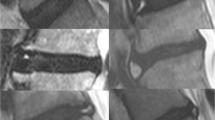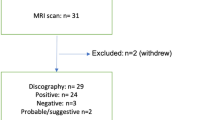Abstract
Purpose
MRS was shown to reliably quantify relative levels of degenerative pain biomarkers, differentiating painful versus non-painful discs in patients with chronic discogenic low back pain (DLBP), and this correlates with surgical success rates. We now report results based on more patients and longer follow-up.
Methods
Disc MRS was performed in DLBP patients who subsequently received lumbar surgery. Custom post-processing (NOCISCAN-LS®; Aclarion Inc.) calculated disc-specific NOCISCORES® that reflect relative differences in degenerative pain biomarkers for diagnosing chemically painful discs. Outcomes in 78 patients were evaluated using Oswestry Disability Index (ODI) scores. Surgical success (≥ 15-point ODI improvement) was compared between surgeries that were “Concordant” (Group C) versus “Discordant” (Group D) with NOCISCORE-based diagnosis for painful discs.
Results
Success rates were higher for Group C versus Group D: 6 months (88% vs. 62%; p = 0.01), 12 months (91% vs. 56%; p < 0.001), and 24 months (85% vs. 63%; p = 0.07). Success rates for Group C surgeries were also higher than Group D surgeries in a variety of sub-group comparisons. Group C had a greater reduction in ODI from pre-operative to follow-up than Group D [absolute change (% change), (p)]: 6 months: − 35 (− 61%) versus − 23 (− 39%), (p < 0.05); 12 months: − 39 (− 69%) versus − 22 (− 39%), (p < 0.01); and 24 months: − 38 (− 66%) versus − 26 (− 48%), (p < 0.05).
Conclusion
More successful, sustained outcomes were obtained when surgically treating chemically painful discs identified by NOCISCAN-LS post-processed disc MRS exams. Results suggest that NOCISCAN-LS provides a valuable new diagnostic tool to help clinicians better select treatment levels.







Similar content being viewed by others
References
Corns J (2018) Recent work on pain. Anal Rev 78:737–753
Ota Y, Connolly M, Srinivasan A, Kim J, Capizzano AA, Moritani T (2020) Mechanisms and origins of spinal pain: from molecules to anatomy, with diagnostic clues and imaging findings. Radiographics 40:1163–1181. https://doi.org/10.1148/rg.2020190185
Vagaska E, Litavcova A, Srotova I, Vlckova E, Kerkovsky M, Jarkovsky J, Bednarik J, Adamova B (2019) Do lumbar magnetic resonance imaging changes predict neuropathic pain in patients with chronic non-specific low back pain? Medicine (Baltimore) 98:e15377. https://doi.org/10.1097/MD.0000000000015377
Keshari KR, Lotz JC, Kurhanewicz J, Majumdar S (2005) Correlation of HR-MAS spectroscopy derived metabolite concentrations with collagen and proteoglycan levels and Thompson grade in the degenerative disc. Spine 30:2683–2688
Keshari KR, Lotz JC, Link TM, Hu S, Majumdar S, Kurhanewicz J (2008) Lactic acid and proteoglycans as metabolic markers for discogenic back pain. Spine (Phila Pa 1976) 33:312–317. https://doi.org/10.1097/BRS.0b013e31816201c3
Magnitsky S, Dudli S, Tang X, Kaur J, Diaz J, Miller S, Lotz JC (2018) Quantification of propionic acid in the bovine spinal disk after infection of the tissue with Propionibacteria acnes bacteria. Spine (Phila Pa 1976) 43:E634–E638. https://doi.org/10.1097/BRS.0000000000002448
Gornet MG, Peacock J, Claude J, Schranck FW, Copay AG, Eastlack RK, Benz R, Olshen A, Lotz JC (2019) Magnetic resonance spectroscopy (MRS) can identify painful lumbar discs and may facilitate improved clinical outcomes of lumbar surgeries for discogenic pain. Eur Spine J. https://doi.org/10.1007/s00586-018-05873-3
Wolfer LR, Derby R, Lee JE, Lee SH (2008) Systematic review of lumbar provocation discography in asymptomatic subjects with a meta-analysis of false-positive rates. Pain Physician 11:513–538
Copay AG, Glassman SD, Subach BR, Berven S, Schuler TC, Carreon LY (2008) Minimum clinically important difference in lumbar spine surgery patients: a choice of methods using the Oswestry disability index, medical outcomes study questionnaire short form 36, and pain scales. Spine J 8:968–974
Zigler J, Delamarter R, Spivak JM, Linovitz RJ, Danielson GO, Haider TT III, Cammisa F, Zuchermann J, Balderston R, Kitchel S, Foley K, Watkins R, Bradford D, Yue J, Yuan H, Herkowitz H, Geiger D, Bendo J, Peppers T, Sachs B, Girardi F, Kropf M, Goldstein J (2007) Results of the prospective, randomized, multicenter food and drug administration investigational device exemption study of the ProDisc-L total disc replacement versus circumferential fusion for the treatment of 1-level degenerative disc disease. Spine (Phila Pa 1976) 32:1155–1162. https://doi.org/10.1097/BRS.0b013e318054e377
Garcia R Jr, Yue JJ, Blumenthal S, Coric D, Patel VV, Leary SP, Dinh DH, Buttermann GR, Deutsch H, Girardi F, Billys J, Miller LE (2015) Lumbar total disc replacement for discogenic low back pain: two-year outcomes of the activL multicenter randomized controlled IDE clinical trial. Spine (Phila Pa 1976) 40:1873–1881. https://doi.org/10.1097/BRS.0000000000001245
Gornet MF, Burkus JK, Shaffrey ME, Argires PJ, Nian H, Harrell FE Jr (2015) Cervical disc arthroplasty with PRESTIGE LP disc versus anterior cervical discectomy and fusion: a prospective, multicenter investigational device exemption study. J Neurosurg 23:558–573. https://doi.org/10.3171/2015.1.SPINE14589
Wei J, Song Y, Sun L, Chaoliang LV (2013) Comparison of artificial total disc replacement versus fusion for lumbar degenerative disc disease: a meta-analysis of randomized controlled trials. Int Orthop 37:1315–1325
Rajasekaran S, Tangavel C, Vasudevan G, Easwaran M, Muthurajan R, Vijay Anand KS, Murugan C, Nayagam SM, Kanna RM, Shetty AP (2022) Bacteria in human lumbar discs - subclinical infection or contamination? Metabolomic evidence for colonization, multiplication, and cell-cell cross-talk of bacteria. Spine J. https://doi.org/10.1016/j.spinee.2022.05.001
Khor S, Lavallee D, Cizik AM, Bellabarba C, Chapman JR, Howe CR, Lu D, Mohit AA, Oskouian RJ, Roh JR, Shonnard N, Dagal A, Flum DR (2018) Development and validation of a prediction model for pain and functional outcomes after lumbar spine surgery. JAMA Surg 153:634–642. https://doi.org/10.1001/jamasurg.2018.0072
Anderson JT, Haas AR, Percy R, Woods ST, Ahn UM, Ahn NU (2015) Clinical depression is a strong predictor of poor lumbar fusion outcomes among workers’ compensation subjects. Spine (Phila Pa 1976) 40:748–756. https://doi.org/10.1097/BRS.0000000000000863
Carreon LY, Glassman SD, Howard J (2008) Fusion and nonsurgical treatment for symptomatic lumbar degenerative disease: a systematic review of Oswestry Disability Index and MOS short form-36 outcomes. Spine J 8:747–755. https://doi.org/10.1016/j.spinee.2007.06.013
LaCaille RA, DeBerard MS, Masters KS, Colledge AL, Bacon W (2005) Presurgical biopsychosocial factors predict multidimensional patient: outcomes of interbody cage lumbar fusion. Spine J 5:71–78. https://doi.org/10.1016/j.spinee.2004.08.004
Cuneo JG, DeBerard MS, Wheeler AJ (2017) Lumbar fusion in utah workers’ compensation patients: changing outcomes across a decade. Spine (Phila Pa 1976) 42:692–699. https://doi.org/10.1097/BRS.0000000000001964
Author information
Authors and Affiliations
Corresponding author
Ethics declarations
Conflict of interest
The sponsor, Aclarion, Inc., funded the study. No other funds, grants, or other support was received. All authors are stockholders in Aclarion, Inc.
Ethical approval
All procedures performed in studies involving human participants were in accordance with the ethical standards of the institutional and/or national research committee and with the 1964 Helsinki Declaration and its later amendments or comparable ethical standards. All patients signed an IRB-approved Informed Consent (Western Institutional Review Board).
Additional information
Publisher's Note
Springer Nature remains neutral with regard to jurisdictional claims in published maps and institutional affiliations.
Rights and permissions
Springer Nature or its licensor (e.g. a society or other partner) holds exclusive rights to this article under a publishing agreement with the author(s) or other rightsholder(s); author self-archiving of the accepted manuscript version of this article is solely governed by the terms of such publishing agreement and applicable law.
About this article
Cite this article
Gornet, M.F., Eastlack, R.K., Peacock, J. et al. Magnetic resonance spectroscopy (MRS) identification of chemically painful lumbar discs leads to improved 6-, 12-, and 24-month outcomes for discogenic low back pain surgeries. Eur Spine J 32, 1973–1984 (2023). https://doi.org/10.1007/s00586-023-07665-w
Received:
Revised:
Accepted:
Published:
Issue Date:
DOI: https://doi.org/10.1007/s00586-023-07665-w




